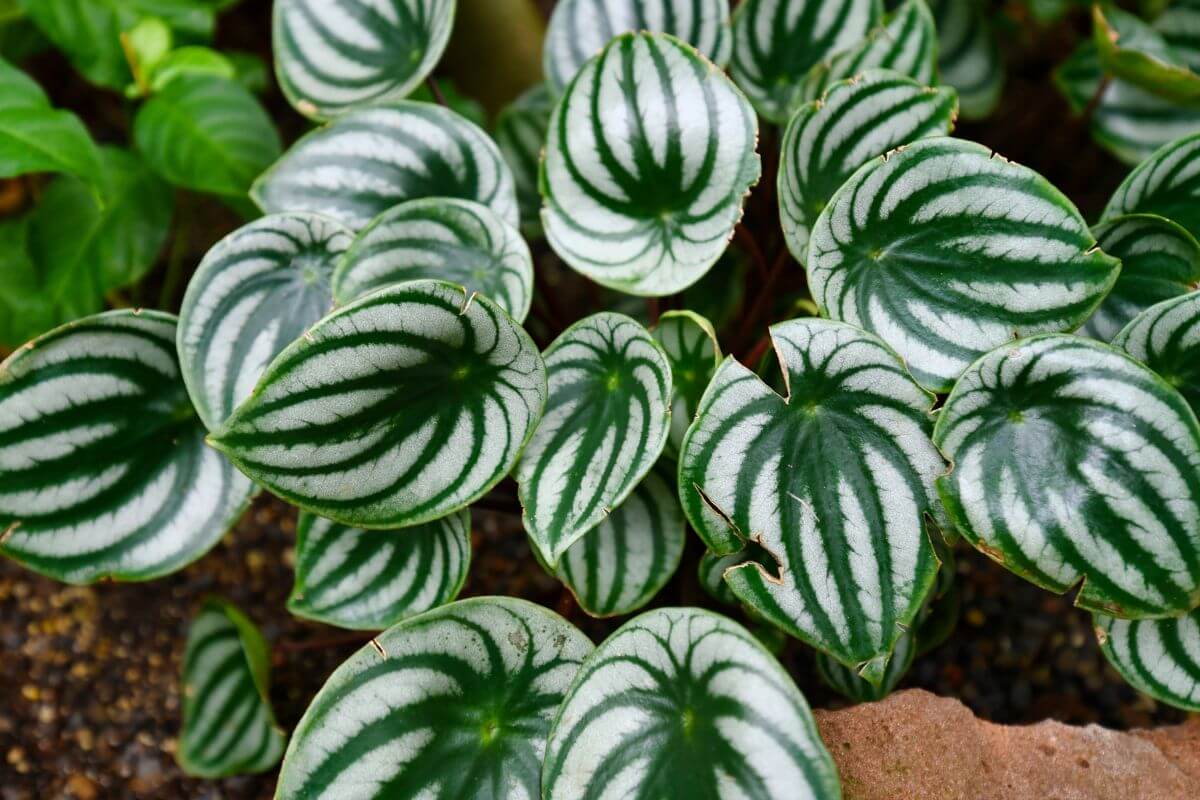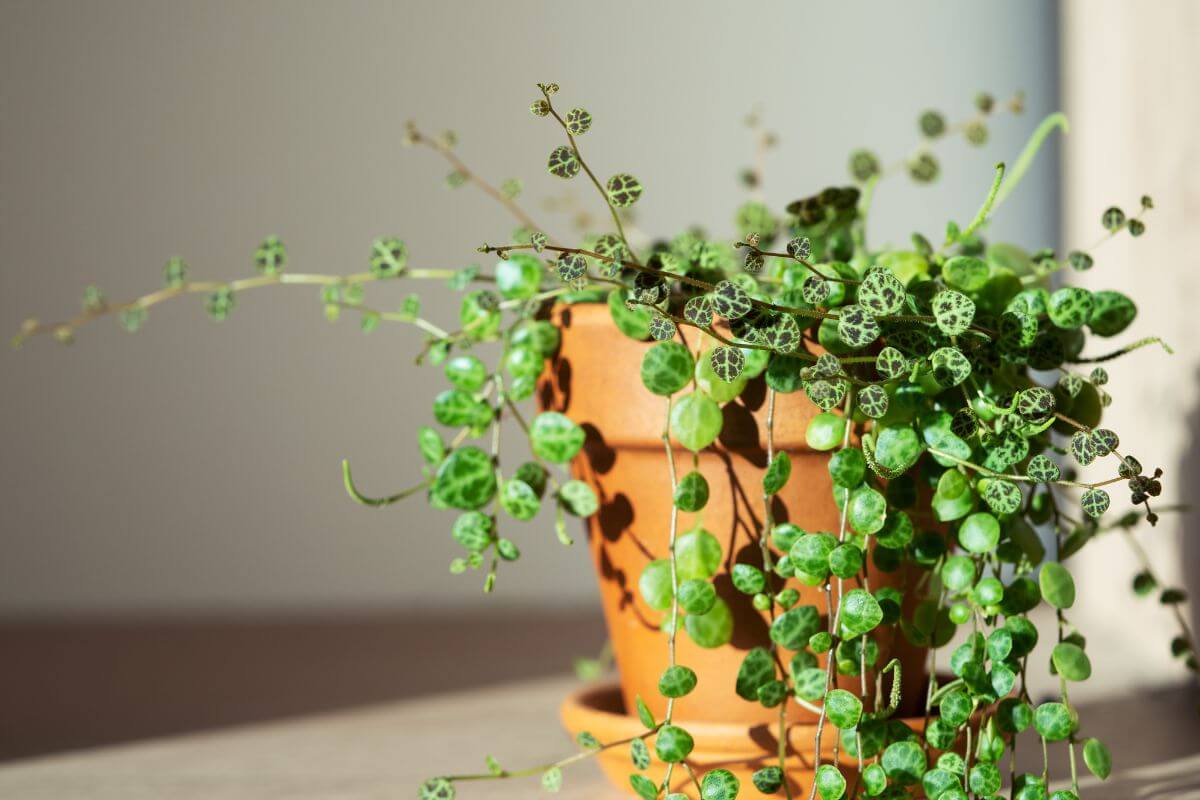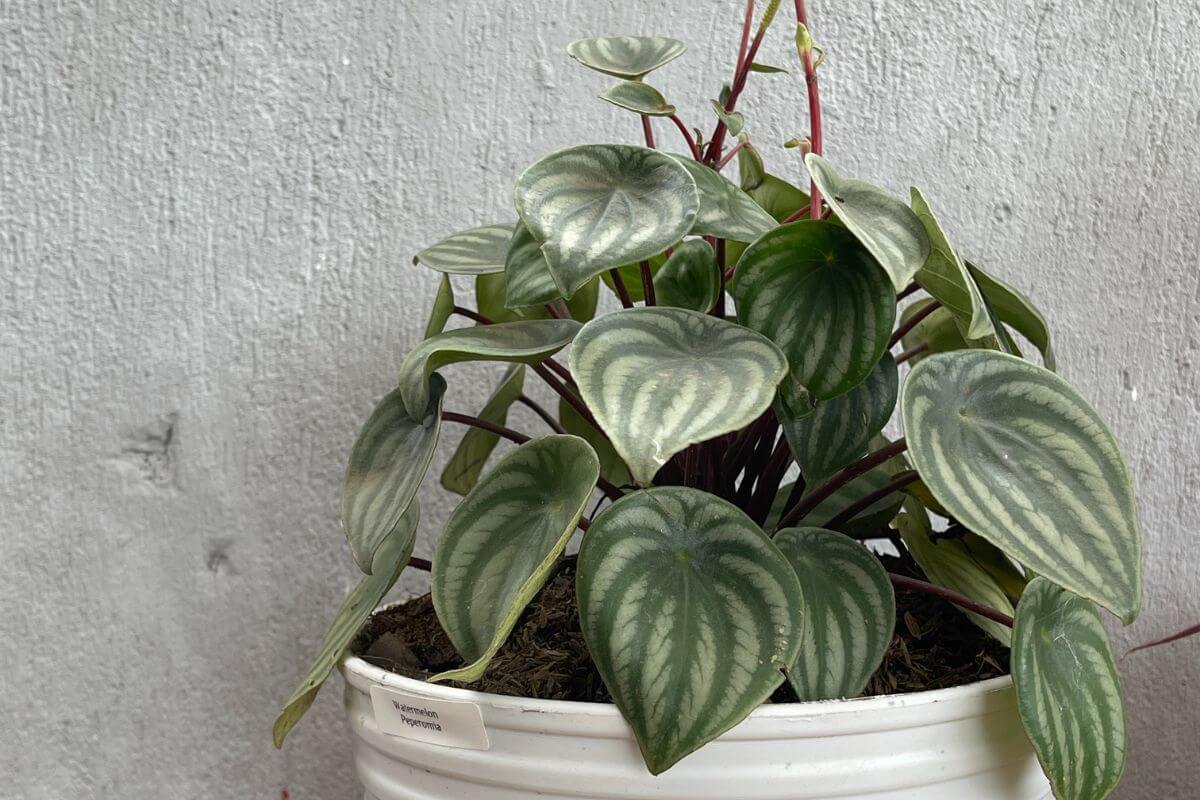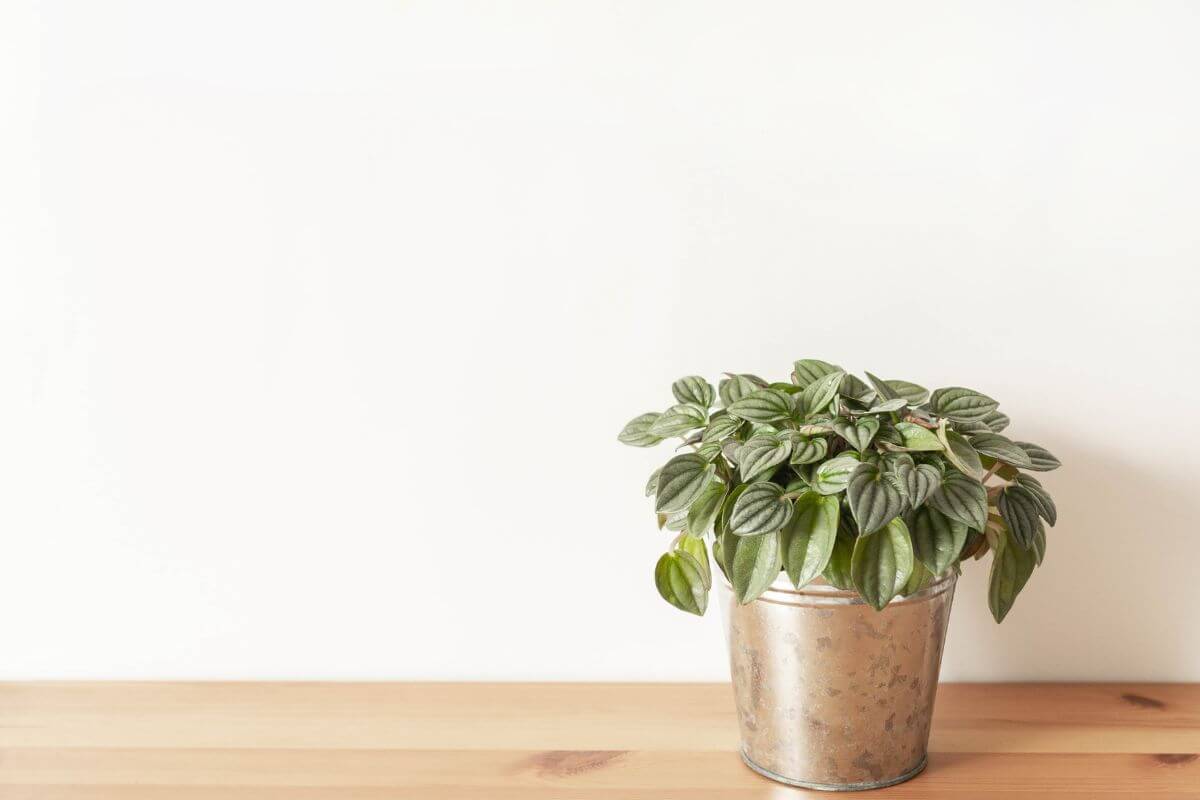Peperomia plants are charming houseplants celebrated for their diverse leaf shapes and colors, as well as their easy care.
With over 1,000 species, these plants are adaptable and can thrive in various indoor conditions. This guide covers everything you need to know about Peperomia care, from light and watering needs to propagation and pest management.
5 Key Takeaways on Peperomia Plant Care
- Peperomia plants come in many types, including Peperomia obtusifolia, Peperomia argyreia, and Peperomia caperata, each with unique foliage and sizes.
- They prefer bright, indirect sunlight but can tolerate lower light. Avoid direct sun to prevent leaf scorch.
- Water only when the top inch of soil is dry, as these plants are susceptible to root rot.
- Peperomia houseplants thrive in moderate humidity and temperatures between 65°F and 75°F (18°C to 24°C).
- Common issues include mealybugs, spider mites, and root rot, which can be managed with proper care.
Overview of the Peperomia Plant

Peperomia plants are popular houseplants known for their unique characteristics and adaptability. The table below shows some key details about them:
| Feature | Details |
|---|---|
| Leaf Structure | Thick, fleshy leaves; can be oval, round, heart-shaped, or pointy with smooth or rippled textures. |
| Size | Compact, growing 6 inches to 1 foot, ideal for small spaces. |
| Foliage Colors | Green, variegated with silver, white, pale yellow, or deep red markings. |
| Native Regions | Found in subtropical and tropical areas of Central and South America. |
| Nicknames | Radiator Plant, Baby Rubber Plant (Peperomia obtusifolia), Raindrop Peperomia, Watermelon Peperomia. |
| Care Requirements | Low-maintenance; thrives in indirect light and tolerates lower humidity. |
| Non-Toxicity | Safe for pets; non-toxic. |
Different Varieties of Peperomia Plant
Peperomia is a diverse plant genus with over 1,000 species, loved as houseplants for their attractive foliage and easy care. Below are some popular Peperomia varieties:
| Variety | Description | Size |
|---|---|---|
| Peperomia obtusifolia | Thick, glossy leaves resembling the rubber plant; can be variegated with creamy white or yellow. | 6 to 12 inches tall |
| Peperomia argyreia | Green leaves with silver striping, resembling mini watermelons. | 6 to 8 inches tall |
| Peperomia caperata | Deeply ridged leaves in various colors, including green and red. | Up to 8 inches tall and wide |
| Peperomia clusiifolia | Variegated foliage with pink or red margins, also called Jelly or Tricolor Peperomia. | 6 to 12 inches tall |
| Peperomia prostrata | Trailing variety with small, round leaves patterned like turtle shells. | Trails up to 12 inches |
| Peperomia caperata ‘Rosso’ | Dark green leaves with striking red undersides and unique texture. | About 8 inches tall |
| Peperomia graveolens | Vibrant red stems with thick, fleshy leaves. | Up to 10 inches tall |
| Peperomia puteolata | Uniquely veined leaves with both vertical and horizontal stripes. | 15-20 inches long, 6-8 inches tall |
| Peperomia albovittata | Light green leaves with deep, ridged dark green veins and reddish-brown stems. | 6 to 12 inches tall |
| Peperomia ‘Mendoza’ | Silvery-green leaves with burgundy undersides. | About 8 inches tall |
Peperomia Plant Care Guide
Peperomia plants are easy to care for but have specific needs to thrive. Let’s break down their key care requirements.
Peperomia Plant Soil Requirements
Peperomia plants thrive in well-draining potting mix that allows water to escape while keeping some moisture. A mix with peat moss and perlite works best for aeration and preventing waterlogging.
Orchid potting medium also suits their need for loose, chunky soil. You can improve regular potting soil by adding coconut coir or perlite for better drainage.
The ideal soil pH for Peperomias is between 6.0 and 7.0, which promotes healthy growth.
Additional tips:
- Use pots with drainage holes to avoid soggy soil and root rot.
- Peperomia houseplants can handle being slightly root-bound. Choose a pot only slightly larger than the root ball.
- The soil should hold some moisture but not become overly wet.
Peperomia Plant Light Requirements

Peperomia plants do best in bright, indirect sunlight, similar to the filtered light they get in their natural habitat under tree canopies.
Direct sunlight can scorch their leaves, causing damage and discoloration. Keep them away from harsh sun, especially in summer.
While they can handle low light, they won’t grow as well or keep their vibrant colors. In low light, Peperomias may grow leggy as they reach for more light.
East or west-facing windows are ideal. If near a south-facing window, place them at least 5 feet away to avoid leaf burn. If the plant shows leggy growth or drooping leaves, moving it to a brighter spot can improve its health.
Peperomia Plant Water and Humidity Requirements
Peperomia plants prefer moderate watering and high humidity levels. Be careful not to overwater, as it can lead to root rot. Water from the bottom by placing the plant in a dish, allowing it to absorb what it needs, and remove any leftover water to avoid fungal issues.
Peperomia’s fleshy leaves store water, so it’s better to let the soil dry out between waterings, especially for thick-leaved varieties. In dry environments, increase humidity using a humidifier or pebble tray, ensuring the pot doesn’t sit directly in water.
Peperomia Plant Fertilizer Requirements
Peperomia plants need the right fertilizer for healthy growth. Here’s an easy guide to their fertilizer needs:
Fertilizer Type:
- Use a balanced, water-soluble fertilizer. Look for N-P-K ratios like 2-2-2, 3-1-2, or 10-10-10 to give the plant essential nutrients.
Fertilization Schedule:
- Growing Season – Feed every 4 to 6 weeks in spring and summer when the plant is actively growing.
- Dormant Period – Don’t fertilize in fall and winter when growth slows to avoid fertilizer burn.
How to Apply:
- Liquid Fertilizer – Dilute according to the instructions and apply during watering for even nutrient distribution.
- Granular Fertilizer – Follow dosage guidelines, sprinkle around the base, and water to help nutrients reach the roots.
Signs of Nutrient Deficiency:
- Stunted growth, yellowing leaves, or wilting can signal nutrient needs. Yellowing older leaves may mean a nitrogen deficiency, while lack of phosphorus can slow growth.
Recommended Fertilizers:
- Espoma Organic Indoor! (2-2-2) liquid fertilizer
- FoxFarm Grow Big (6-4-4) liquid concentrate
- Balanced indoor plant food with proper N-P-K ratios
Peperomia Plant Temperature Requirements
Peperomia plants do best in temperatures between 65°F and 75°F (18°C to 24°C), which helps keep them healthy and vibrant.
They can handle temperatures up to 80°F (27°C) but should be protected from extreme heat to avoid wilting or leaf damage. Keep them away from temperatures below 50°F (10°C), as cold can cause stress, slow growth, and lead to leaf drop.
Indoors, avoid placing them near radiators or air conditioners to prevent sudden temperature changes. If placed outdoors in warmer months, bring them inside before temperatures drop below 50°F (10°C).
Look for drooping or browning leaves as signs of temperature stress, and move the plant if needed to keep it healthy.
How to Prune the Peperomia Plant

Here’s a simple guide on how to prune your Peperomia to keep it healthy and looking its best:
- Timing – Prune in early spring when the plant is actively growing.
- Tools Needed – Use clean, sharp scissors or pruning shears for precise cuts.
- What to Prune – Remove dead or yellow leaves and trim leggy stems to encourage bushy growth.
- Pruning Technique – Pinch or cut stems just above a leaf node to stimulate new growth.
- Post-Pruning Care – After pruning, continue to provide proper light and water for recovery and growth.
How to Repot the Peperomia Plant
Follow this quick guide on how to repot your Peperomia to keep it thriving:
- Timing – Repot every 2-3 years or when roots grow out of the drainage holes.
- Choose the Right Pot – Pick a pot 1-2 inches larger with drainage holes to prevent waterlogging.
- Prepare the Potting Mix – Use a well-draining mix like peat moss and perlite or orchid medium.
- Water Before Repotting – Water a day before to ease root removal.
- Remove the Plant – Gently remove the plant, carefully loosening any root-bound roots.
- Repotting Process – Add fresh soil, center the plant, and fill in, keeping the root ball slightly below the rim.
- Water Thoroughly – Water until it drains to settle the soil.
- Post-Repot Care – Place in bright, indirect light and water when the top inch of soil is dry.
How to Propagate the Peperomia Plant
Propagating Peperomia plants is easy and can be done with stem or leaf cuttings. Here’s a simple guide to help you propagate Peperomia successfully:
| Propagation Method | Materials Needed | Steps | Humidity and Care |
|---|---|---|---|
| Stem Cuttings | Clean, sharp scissors or knife Small pot with well-draining potting mix Optional: rooting hormone | Take Cuttings – Choose a healthy stem with at least two leaves. Cut about 3-4 inches (8-10 cm) below a leaf node. Prepare the Cutting – Remove leaves from the bottom half to prevent rot. Use the Rooting Method: In Water – Place the cutting in a jar of water, making sure the cut end is submerged. Change the water weekly until roots form. In Soil – Dip the cut end in rooting hormone (optional) and plant it in moist potting mix, burying it about an inch deep. | If using soil, cover the pot with a plastic bag to keep humidity high until roots grow. Keep the soil moist but not soggy. |
| Leaf Cuttings | Clean scissors Small pot with well-draining potting mix Optional: rooting hormone | Select a Leaf – Pick a healthy, mature leaf and cut it from the plant. Prepare the Leaf – Cut the leaf in half horizontally or leave it whole if using a petiole (the leaf stem). Planting – Insert the cut edge or petiole into moist potting mix, burying it well. Alternatively, you can put the leaf in water until roots grow and then transfer it to soil. | Cover with a plastic bag to keep humidity high and place in indirect light until roots form. |
Peperomia Plant Pests, Diseases, and Problems

Peperomia plants can attract various pests that may harm their health. Here are some common pests you might encounter and how to manage them:
| Pest | Description | Symptoms | Control |
|---|---|---|---|
| Mealybugs | Small, white, cottony insects that suck sap. | Sticky honeydew on leaves; sooty mold growth. | Remove manually or treat with insecticidal soap or neem oil. |
| Spider Mites | Tiny pests that thrive in dry conditions. | Yellowing leaves, webbing, curled or brittle leaves. | Increase humidity and use insecticidal soap or miticides. |
| Scale Insects | Small, waxy bumps on stems and leaves. | Yellowing leaves and stunted growth. | Remove by hand or treat with horticultural oil. |
| Fungus Gnats | Small flies that thrive in moist soil. | Larvae feed on roots, causing weakened plants. | Allow soil to dry out and use sticky traps. |
| Thrips | Tiny insects that can damage leaves. | Silvery streaks on leaves and distorted growth. | Use insecticidal soap or neem oil. |
Peperomia plants can also be affected by various diseases that can hinder their growth. Here’s a look at some common diseases and how to control them:
| Disease | Cause | Symptoms | Control |
|---|---|---|---|
| Root Rot | Overwatering and poorly draining soil cause fungal infections. | Black, mushy roots and yellowing leaves. | Ensure proper drainage, reduce watering, and use fresh potting mix. |
| Leaf Spot Diseases | Various fungi cause leaf spots. | Irregular brown spots (Cercospora), dark brown spots (Phyllosticta), mushy dark spots with rings (Rhizoctonia). | Improve air circulation, remove affected leaves, and apply fungicides if necessary. |
| Powdery Mildew | High humidity and poor air circulation. | White powdery coating on leaves. | Increase airflow around the plant and apply fungicides if needed. |
| Ring Spot Virus | Viral infection spread through contaminated cuttings. | Concentric rings on leaves and stunted growth. | No treatment; dispose of infected plants. |
Peperomia plants may face some general care issues that can affect their health. Here are some common problems and tips for addressing them:
| Problem | Description | Solution |
|---|---|---|
| Overwatering | Most common issue leading to yellowing or curling leaves. | Ensure pots have drainage holes and let the top inch of soil dry before watering. |
| Underwatering | Can cause wilting and stunted growth. | Water thoroughly when the top layer of soil feels dry. |
| Environmental Stress | Excessive heat or cold drafts can lead to leaf drop or browning edges. | Keep plants in stable temperatures away from direct heat sources. |
Is the Peperomia Plant Toxic to Pests?
Peperomia plants are safe for pets, including cats and dogs. Here are the important details about their safety and care:
- Non-Toxic Status – Peperomia plants are considered completely safe for cats and dogs, according to the ASPCA. They do not have harmful substances that could poison pets if eaten.
- Caution With Overeating – While Peperomia is non-toxic, it’s still a good idea to keep an eye on your pets. If they eat a lot, they might have mild stomach upset, like vomiting or nausea, but this is usually not serious.
Peperomia Plant Care Final Thoughts
Peperomia plants are not only safe for pets but also make a wonderful addition to any home due to their attractive appearance and low maintenance.
By following the care tips outlined in this guide, you can enjoy a healthy and thriving Peperomia that brightens your space. Explore further resources to discover more about these delightful houseplants!
Peperomia Plant Care FAQs
1. Is Peperomia a Good Indoor Plant?
Yes, the peperomia makes for a great indoor plant because it doesn’t require much attention. You don’t have to provide direct sun, as they can also thrive under artificial lighting. They prefer warm temperatures and moist environments. Water them regularly during hot weather.
2. How Do I Care for the Roots of My Peperomia Plant?
Peperomia plants have shallow root systems, so it’s essential to be mindful when caring for the root ball. Make sure the plant is in well-draining soil to prevent root rot. Water the plant when the top inch of soil feels dry, and avoid letting the root ball sit in water, as this can lead to overwatering.
3. What Kind of Light Does a Peperomia Need?
Peperomia is a tropical plant that thrives in bright, indirect sunlight. Direct sunlight can scorch the succulent leaves, so it’s best to keep the plant in a spot where it can receive filtered light. If the plant isn’t getting enough light, you may notice yellow leaves or slower growth.
4. Why Is My Peperomia an Upright Plant Instead of Spreading?
Some varieties of Peperomia naturally grow as an upright plant rather than spreading. If you notice the plant becoming leggy or top-heavy, it may be a sign that it’s reaching for more light.
5. Is Peperomia a Succulent?
No, the peperomia is not actually a succulent, even though it looks similar to one. Succulents are cacti and agaves while the peperomia belongs to the lily family.
The peperomia does share some characteristics with succulents such as being drought tolerant, growing slowly, and producing flowers year after year. But unlike succulents, peperomia plants produce blooms throughout the entire summer season.
Discover more houseplant care guides to explore and nurture a variety of amazing plants:
- Learn to Care for Peace Lilies
- Philodendron billietiae Grow Guide
- Philodendron Birkin Care and Grow Guide
- Guide to Growing Philodendron Black Knights
- https://ipm.missouri.edu/meg/2022/2/peperomia-DT/
- https://plants.usda.gov/home/classification/72211
- https://www.nparks.gov.sg/florafaunaweb/flora/5/5/5557
- https://www.ncbi.nlm.nih.gov/pmc/articles/PMC8950162/
- https://mrec.ifas.ufl.edu/Foliage/folnotes/pep.htm
- https://portal.ct.gov/caes/plant-pest-handbook/pphp/peperomia-peperomia
- https://plants.ces.ncsu.edu/plants/peperomia-caperata/










